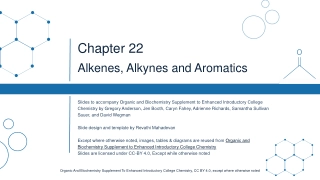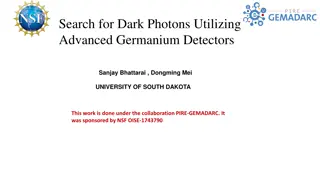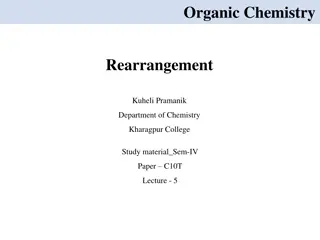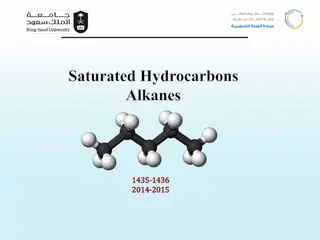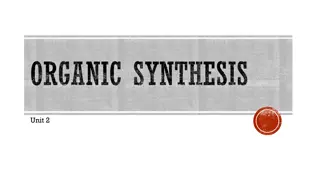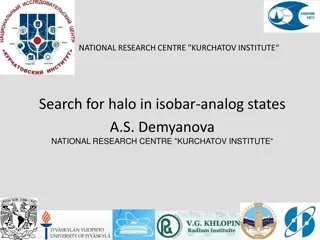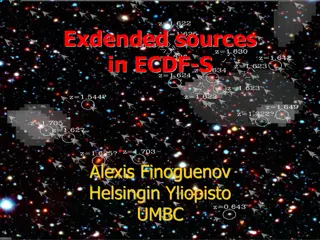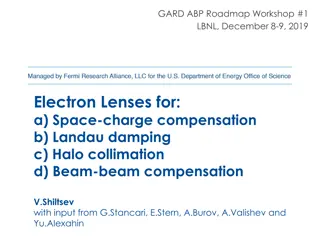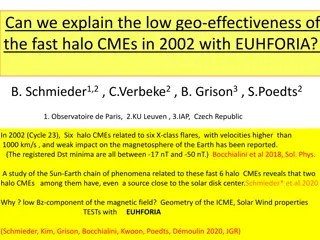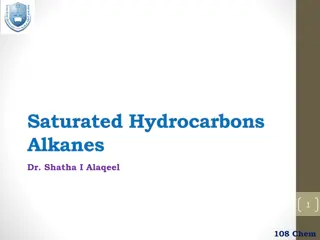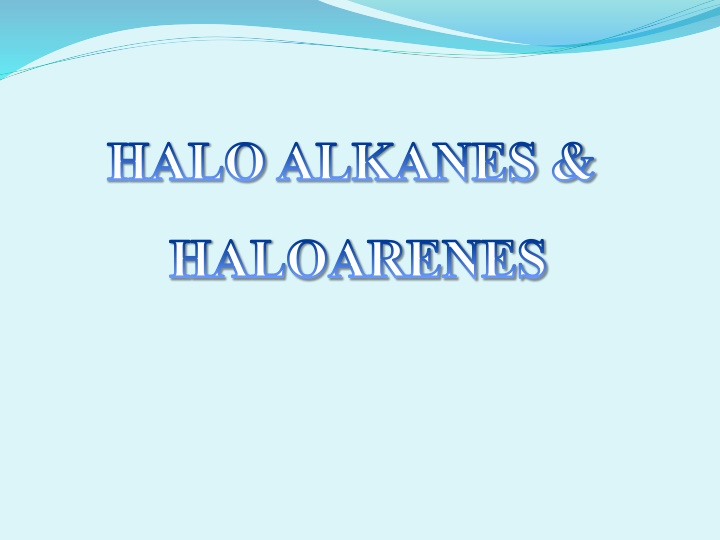
Haloalkanes and Haloarenes: Structures, Isomerism, and Properties
Explore the structures, nomenclature, structural isomerism, physical properties, and nucleophilic substitution reactions of haloalkanes and haloarenes. Learn about their functional groups, classification based on halogen environment, naming conventions, and how molecular size and branching affect properties like boiling points and solubility. Understand the theory behind nucleophilic substitution reactions in halogenoalkanes.
Download Presentation

Please find below an Image/Link to download the presentation.
The content on the website is provided AS IS for your information and personal use only. It may not be sold, licensed, or shared on other websites without obtaining consent from the author. If you encounter any issues during the download, it is possible that the publisher has removed the file from their server.
You are allowed to download the files provided on this website for personal or commercial use, subject to the condition that they are used lawfully. All files are the property of their respective owners.
The content on the website is provided AS IS for your information and personal use only. It may not be sold, licensed, or shared on other websites without obtaining consent from the author.
E N D
Presentation Transcript
HALOALKANES & HALOARENES
STRUCTURE OF HALOGENOALKANES Format Contain the functional group C-Xwhere X is a halogen (F,Cl,Br or I) Halogenoalkanes - halogen is attached to an aliphatic skeleton - alkyl group Haloarenes - halogen is attached directly to a benzene (aromatic) ring Structural differenceHalogenoalkanes are classified according to the environment of the halogen PRIMARY 1 SECONDARY 2 TERTIARY 3
STRUCTURE OF HALOGENOALKANES Format Contain the functional group C-Xwhere X is a halogen (F,Cl,Br or I) Halogenoalkanes - halogen is attached to an aliphatic skeleton - alkyl group Haloarenes - halogen is attached directly to a benzene (aromatic) ring Structural differenceHalogenoalkanes are classified according to the environment of the halogen PRIMARY 1 SECONDARY 2 TERTIARY 3 Names Based on original alkane with a prefix indicating halogens and position. CH3CH2CH2Cl 1-chloropropane CH2ClCHClCH31,2-dichloropropane CH3CBr(CH3)CH3 2-bromo-2-methylpropane CH3CHClCH3 2-chloropropane
STRUCTURAL ISOMERISM IN HALOGENOALKANES Different structures are possible due to... Different positions for the halogen and branching of the carbon chain 1-chlorobutane 2-chlorobutane 2-chloro-2-methylpropane 1-chloro-2-methylpropane
PHYSICAL PROPERTIES Boiling point Increases with molecular size due to increased van der Waals forces chloroethane 1- chloropropane 1-bromopropane Mr 64.5 78.5 124 bp / C 13 47 71 Boiling point also increases for straight chain isomers. Greater branching = lower inter-molecular forces 1-bromobutane 2-bromobutane CH3CH2CH2CH2Br 101 CH3CH2CHBrCH3 91 (CH3)3CBr bp / C 2-bromo -2-methylpropane 73 Solubility Halogenoalkanes are soluble in organic solvents but insoluble in water
NUCLEOPHILIC SUBSTITUTION Theory halogens have a greater electronegativity than carbon electronegativity is the ability to attract the shared pair in a covalent bond a dipole is induced in the C-X bond and it becomes polar the carbon is thus open to attack by nucleophiles nucleophile means liking positive the greater electronegativity of the halogen attracts the shared pair of electrons so it becomes slightly negative; the bond is now polar.
MIND MAP ON PREPARATION OF HALOALKANES
NUCLEOPHILIC SUBSTITUTION Theory halogens have a greater electronegativity than carbon electronegativity is the ability to attract the shared pair in a covalent bond a dipole is induced in the C-X bond and it becomes polar the carbon is thus open to attack by nucleophiles nucleophile means liking positive the greater electro negativity of the halogen attracts the shared pair of electrons so it becomes slightly negative; the bond is now polar. NUCLEOPHILES ELECTRON PAIR DONORS possess at least one LONE PAIR of electrons don t have to possess a negative charge are attracted to the slightly positive (electron deficient) carbon examples are OH , CN , NH3 and H2O (water is a poor nucleophile) OH CN NH3 H2O
NUCLEOPHILIC SUBSTITUTION - MECHANISM the nucleophile uses its lone pair to provide the electrons for a new bond the halogen is displaced - carbon can only have 8 electrons in its outer shell the result is substitution following attack by a nucleophile the mechanism is therefore known as - NUCLEOPHILIC SUBSTITUTION
NUCLEOPHILIC SUBSTITUTION - MECHANISM the nucleophile uses its lone pair to provide the electrons for a new bond the halogen is displaced - carbon can only have 8 electrons in its outer shell the result is substitution following attack by a nucleophile the mechanism is therefore known as - NUCLEOPHILIC SUBSTITUTION Points the nucleophile has a lone pair of electrons the carbon-halogen bond is polar a curly arrow is drawn from the lone pair to the slightly positive carbon atom a curly arrow is used to show the movement of a pair of electrons carbon is restricted to 8 electrons in its outer shell - a bond must be broken the polar carbon-halogen bond breaks heterolytically (unevenly) the second curly arrow shows the shared pair moving onto the halogen the halogen now has its own electron back plus that from the carbon atom it now becomes a negatively charged halide ion a halide ion (the leaving group) is displaced
NUCLEOPHILIC SUBSTITUTION - RATE OF REACTION Basics An important reaction step is the breaking of the carbon-halogen (C-X) bond The rate of reaction depends on the strength of the C-X bond C-I 238 kJmol-1 weakest - easiest to break C-Br C-Cl C-F 276 kJmol-1 338 kJmol-1 484 kJmol-1 strongest - hardest to break
NUCLEOPHILIC SUBSTITUTION - RATE OF REACTION Basics An important reaction step is the breaking of the carbon-halogen (C-X) bond The rate of reaction depends on the strength of the C-X bond C-I 238 kJmol-1 weakest - easiest to break C-Br C-Cl C-F 276 kJmol-1 338 kJmol-1 484 kJmol-1 strongest - hardest to break Experiment Water is a poor nucleophile but it can slowly displace halide ions C2H5Br(l) + H2O(l) > C2H5OH(l) + H+ (aq) + Br (aq) If aqueous silver nitrate is shaken with a halogenoalkane (they are immiscible) the displaced halide combines with a silver ion to form a precipitate of a silver halide. The weaker the C-X bond the quicker the precipitate appears.
NUCLEOPHILIC SUBSTITUTION - RATE OF REACTION Basics An important reaction step is the breaking of the carbon-halogen (C-X) bond The rate of reaction depends on the strength of the C-X bond C-I 238 kJmol-1 weakest - easiest to break C-Br C-Cl C-F 276 kJmol-1 338 kJmol-1 484 kJmol-1 strongest - hardest to break Experiment Water is a poor nucleophile but it can slowly displace halide ions C2H5Br(l) + H2O(l) > C2H5OH(l) + H+ (aq) + Br (aq) If aqueous silver nitrate is shaken with a halogenoalkane (they are immiscible) the displaced halide combines with a silver ion to form a precipitate of a silver halide. The weaker the C-X bond the quicker the precipitate appears. This form of nucleophilic substitution is known as SN2; it is a bimolecular process. An alternative method involves the initial breaking of the C-X bond to form a carbocation, or carbonium ion, (a unimolecular process - SN1 mechanism), which is then attacked by the nucleophile. SN1 is favoured for tertiary haloalkanes where there is steric hindrance to the attack and a more stable tertiary, 3 , carbocation intermediate is formed.
NUCLEOPHILIC SUBSTITUTION AQUEOUS SODIUM HYDROXIDE Reagent Conditions Product Nucleophile Aqueous* sodium (or potassium) hydroxide Reflux in aqueous solution (SOLVENT IS IMPORTANT) Alcohol hydroxide ion (OH ) Equation e.g. C2H5Br(l) + NaOH(aq) > C2H5OH(l) + NaBr(aq) Mechanism IMP.NOTE: When answering these questions, solvent must be quoted. Elimination takes place when ethanol is the solvent
NUCLEOPHILIC SUBSTITUTION AQUEOUS SODIUM HYDROXIDE ANIMATED MECHANISM
NUCLEOPHILIC SUBSTITUTION POTASSIUM CYANIDE Reagent Conditions Product Nucleophile Aqueous, alcoholic potassium (or sodium) cyanide Reflux in aqueous , alcoholic solution Nitrile (cyanide) cyanide ion (CN ) Equation e.g. C2H5Br + KCN (aq/alc) > C2H5CN + KBr(aq) Mechanism
NUCLEOPHILIC SUBSTITUTION POTASSIUM CYANIDE Reagent Conditions Product Nucleophile Aqueous, alcoholic potassium (or sodium) cyanide Reflux in aqueous , alcoholic solution Nitrile (cyanide) cyanide ion (CN ) Equation e.g. C2H5Br + KCN (aq/alc) > C2H5CN + KBr(aq) Mechanism Importance extends the carbon chain by one carbon atom the CN group can be converted to carboxylic acids or amines. Hydrolysis Reduction C2H5CN + 2H2O > C2H5COOH + NH3 C2H5CN + 4[H] > C2H5CH2NH2
NUCLEOPHILIC SUBSTITUTION POTASSIUM CYANIDE ANIMATED MECHANISM
NUCLEOPHILIC SUBSTITUTION AMMONIA Reagent Conditions Product Nucleophile Aqueous, alcoholic ammonia (in EXCESS) Reflux in aqueous , alcoholic solution under pressure Amine Ammonia (NH3) Equation e.g. C2H5Br + 2NH3 (aq / alc) > C2H5NH2 + NH4Br (i) C2H5Br + NH3 (aq / alc) > C2H5NH2 + HBr (ii) HBr + NH3 (aq / alc) > NH4Br Mechanism Notes The equation shows two ammonia molecules. The second one ensures that a salt is not formed.
NUCLEOPHILIC SUBSTITUTION AMMONIA Why excess ammonia? The second ammonia molecule ensures the removal of HBr which would lead to the formation of a salt. A large excess ammonia ensures that further substitution doesn t take place - see below Problem Amines are also nucleophiles (lone pair on N) and can attack another molecule of halogenoalkane to produce a 2 amine. This too is a nucleophile and can react further producing a 3 amine and, eventually an ionic quarternary ammonium salt. C2H5NH2 + C2H5Br > HBr + (C2H5)2NH diethylamine, a 2 amine (C2H5)2NH + C2H5Br > HBr + (C2H5)3N triethylamine, a 3 amine (C2H5)3N + C2H5Br > (C2H5)4N+ Br tetraethylammonium bromide a quaternary (4 ) salt
NUCLEOPHILIC SUBSTITUTION WATER Details A similar reaction to that with OH takes place with water. It is slower as water is a poor nucleophile. Equation C2H5Br(l) + H2O(l) > C2H5OH(l) + HBr(aq)
ELIMINATION v. SUBSTITUTION The products of reactions between haloalkanes and OH are influenced by the solvent SOLVENT MECHANISM PRODUCT ROLE OF OH WATER NUCLEOPHILE SUBSTITUTION ALCOHOL ALCOHOL BASE ELIMINATION ALKENE Modes of attack Aqueous soln OH attacks the slightly positive carbon bonded to the halogen. OH acts as a nucleophile Alcoholic soln OH attacks one of the hydrogen atoms on a carbon atom adjacent the carbon bonded to the halogen. OH acts as a base (A BASE IS A PROTON ACCEPTOR) Both reactions take place at the same time but by varying the solvent you can influence which mechanism dominates.
ELIMINATION Reagent Conditions Product Mechanism Equation Alcoholic sodium (or potassium) hydroxide Reflux in alcoholic solution Alkene Elimination C3H7Br + NaOH(alc) > C3H6 + H2O + NaBr Mechanism the OH ion acts as a base and picks up a proton the proton comes from a carbon atom next to that bonded to the halogen the electron pair left moves to form a second bond between the carbon atoms the halogen is displaced overall there is ELIMINATION of HBr. Complication With unsymmetrical halogenoalkanes, you can get mixture of products
ELIMINATION ANIMATED MECHANISM
ELIMINATION Complication The OH removes a proton from a carbon atom adjacent the C bearing the halogen. If there had been another carbon atom on the other side of the C-Halogen bond, its hydrogen(s) would also be open to attack. If the haloalkane is unsymmetrical (e.g. 2- bromobutane) a mixture of isomeric alkene products is obtained. but-1-ene but-2-ene can exist as cis and trans isomers
IMPORTANT POINTS TO REMEMBER: Preparation of Aryl halides from alcohol is not possible because, the C-O bond has a partial double bond character and is difficult to break, being stronger than single bond. Sandmeyer reaction Preparation of Haloarenes from primary amines in the presence of NaNo2, CuCl2. The Boiling point of isomeric haloalkanes decreases with increase in branching. Similarly, p- isomer has high mp compared to their O- and m- isomer due to symmetry of p-isomer that fits in a crystal lattice better as compared to o- and pm- isomer.
IMPORTANT POINTS TO REMEMBER: SN2 reaction- Order of reactivity: Primary > Secondary> Tertiary Reason: The presence of bulky substituent on or near the c atom have a dramatic inhibiting effect SN1 reaction- Order of reactivity: Tertiary > Secondary> Primary Rate Determining step is the slow cleavage of C-Br bond to produce Carbocation and a bromide ion. Rate of reaction is dependent only on the concentration of R-X, greater the stability of Carbocation, greater will be its ease of formation from alkyl halides. SN2 reaction shows Inversion, while SN1 reaction shows racemisation.
IMPORTANT POINTS TO REMEMBER: A mixture containing two enantiomers in equal proportions will have Zero optical rotation as the rotation due to one isomer will be cancelled by the rotation due to other isomer. In case of -elimination, Saytzeff rule is to be remembered. In Dehyrohalogenation, the preferred product is that alkene, which has greater number of alkyl groups attached to the doubly bonded C atoms. Alkyl halides are extremely less reactive to nucleiophyllic Substitution reactions due to resonance effect, difference in hybridization of C- atom in C-X bond, instability of phenyl Cation.
IMPORTANT POINTS TO REMEMBER: Haloarenes undergo electrophillic substitution reactions preferably at o- or p- positions, due to resonance e- density increases at o- or p- positions than at m-position.

